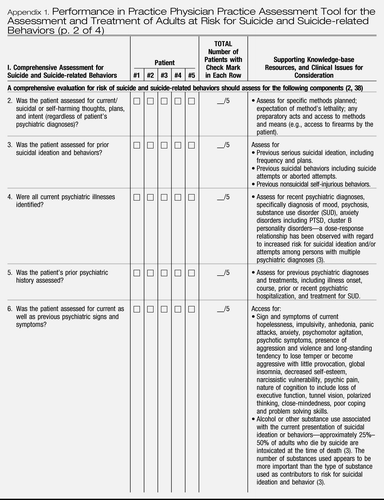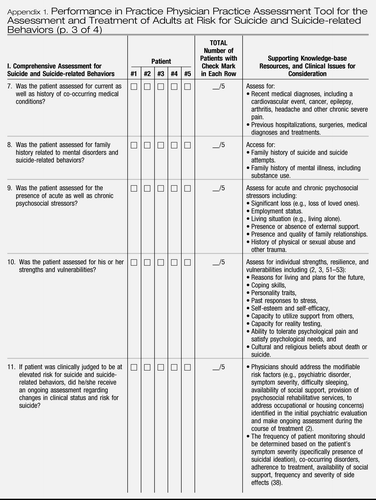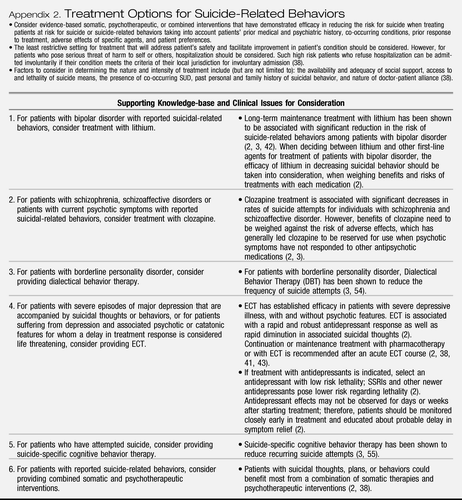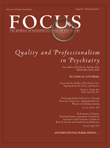Performance in Practice: Physician Practice Assessment Tool for the Assessment and Treatment of Adults at Risk for Suicide and Suicide-Related Behaviors
Abstract
The American Board of Medical Specialties (ABMS) and the American Board of Psychiatry and Neurology (ABPN) are implementing multifaceted Maintenance of Certification (MOC) requirements to enhance quality of patient care and assess and verify the competence of physicians over time (ABPN 2009). Beginning in 2013, for those applying for 2014 MOC examinations, the practice assessment component (Part 4 of MOC) will require physicians to compare their care for five or more patients with “published best practices, practice guidelines or peer-based standards of care and develop a plan to improve effectiveness and efficiency of care delivery in their clinical practice” (ABPN 2009). To this end, the evidence-based Performance in Practice Physician Practice Assessment Tool for the Assessment and Treatment of Adults at Risk for Suicide and Suicide-related Behaviors that is presented here provides psychiatrists with the opportunity to gain experience with practice assessment, in preparation for the new ABMS and ABPN MOC requirements. Moreover, this tool can facilitate implementation of a systematic approach toward practice improvement for the assessment and treatment of patients with suicidal ideation and behavior.
Suicide-related morbidity and mortality among psychiatric patients are ongoing concerns in providing good patient care (1, 2). The vast majority of individuals who experience such morbidity or mortality will have an underlying psychiatric illness (1, 3–14). Population-based evidence has consistently demonstrated that fatal and nonfatal suicidal behaviors can be associated with mood disorders, psychotic disorders, substance use disorders, anxiety disorders, conduct disorder, and antisocial and borderline personality disorders (4, 5, 13–27). Psychiatric disorders represent potentially modifiable risk factors, and their identification and appropriate treatment are central components of efforts to reduce risk for suicide (3, 7, 28).
Suicide fatalities are the 11th leading cause of death in the United States, accounting for 1.4% of all deaths (29). In 2007, the most recent year for which final mortality data are available, the 34,598 suicide deaths in the United States represented a rate of 11.3 deaths per 100,000 individuals (29). The 12-month prevalence of nonfatal suicidal self-injuries among U.S. adults ranges from 0.2% to 0.6% (4, 5, 14–15).
The national burden of injury associated with fatal and nonfatal suicidal behaviors is large and includes hospitalization, emergency department visits, reported events, unreported events that are not medically treated, and suicide mortality. The overall burden translates into nontrivial economic and societal costs, with 376,306 individuals treated in emergency departments and 163,489 hospitalized in 2008 (30), direct costs estimated to be approximately $68 million (31), indirect costs estimated to be $11.8 billion (28), and devastating emotional consequences for families and friends of decedents.
Suicidal behaviors exist along a continuum from fleeting thoughts about suicide at one end to ending one's life at the other end (28). The fundamental features that define suicidal thoughts and behaviors and that distinguish suicidal from nonsuicidal thoughts and behaviors are 1) the act must be self-inflicted, 2) the act must be intentional, and 3) the objective is death (28). A useful nomenclature proposed by O'Carroll and colleagues (2, 32) that reflects these fundamental features and defines a gradation in the continuum of suicide-related behaviors includes the following:
| •. | Suicide: Self-inflicted death with explicit or implicit evidence that the person intended to die | ||||
| •. | Suicide attempt: Self-injurious behavior with a nonfatal outcome accompanied by explicit or implicit evidence that the person intended to die | ||||
| •. | Aborted suicide attempt: Potentially self-injurious behavior with explicit or implicit evidence that the person intended to die but stopped the attempt before physical damage occurred | ||||
| •. | Suicidal ideation: Thought of serving as the agent of one's own death; seriousness may vary depending on the specificity of suicidal plans and the degree of suicidal intent | ||||
| •. | Suicidal intent: Subjective expectation and desire for a self-destructive act to end in death | ||||
| •. | Lethality of suicidal behavior: Objective danger to life associated with a suicide method or action. Note that lethality is distinct from, and may not always coincide with, an individual's expectation of what is medically dangerous. | ||||
| •. | Deliberate self-harm: Willful self-inflicting of painful, destructive, or injurious acts without intent to die | ||||
MAINTENANCE OF CERTIFICATION: PERFORMANCE IN PRACTICE (PIP) PHYSICIAN PRACTICE ASSESSMENT REQUIREMENTS
By 2014, the American Board of Medical Specialties (ABMS) and the American Board of Psychiatry and Neurology (ABPN) plan to implement multifaceted Maintenance of Certification (MOC) requirements to enhance quality of patient care and assess competence of physicians over time (34). The MOC process will include a practice assessment component, requiring physicians to compare their care for five or more patients “with published best practices, practice guidelines or peer-based standards of care.” Based on the results of this practice assessment, physicians are then asked to develop a practice improvement plan to enhance effectiveness and efficiency in delivery of clinical care and reevaluate their practice within 24 months after the initial evaluation (34).
Suicide risk assessment is one of the core components of a comprehensive psychiatric evaluation (35). Given the potential for suicidal ideation and behavior across the spectrum of psychiatric disorders, timely identification and appropriate treatment of mental disorders, which are considered potentially modifiable risk factors, may reduce the probability of patients developing suicidal ideation and behaviors (3). Moreover, several evidence-based treatments are currently available to target suicide-related behaviors. The Performance in Practice Physician Practice Assessment Tool for the Assessment and Treatment of Adults at Risk for Suicide and Suicide-related Behaviors presented in Appendix 1, has been developed in response to new ABMS and ABPN maintenance of certification requirements. This tool provides psychiatrists with an opportunity for practice improvement in a clinical area that poses a substantial burden of injury, morbidity, and mortality across multiple psychiatric diagnoses.
This PIP tool was developed by first identifying key evidence-based assessment and treatment recommendations from practice guidelines of the APA, Veterans Administration and Department of Defense (VA/DoD), and the National Institute for Health and Clinical Excellence (NICE). The APA sources included the Practice Guideline for the Assessment and Treatment of Patients with Suicidal Behaviors (2) (2003), Practice Guideline for Psychiatric Evaluation of Adults (35) (2006), Practice Guideline for the Treatment of Patients With Substance Use Disorders (36) (2006), Guideline Watch: Practice Guideline for the Treatment of Patients with Substance Use Disorders (37) (2007), Practice Guideline for the Treatment of Patients with Major Depressive Disorder (38) (2010), Practice Guideline for the Treatment of Patients with Borderline Personality Disorder (39) (2001), and the Guideline Watch: Practice Guideline for the Treatment of Patients with Borderline Personality Disorder (40) (2005). The VA/DoD sources included the Clinical Practice Guideline: Management of Major Depressive Disorder (41) (2009) and the Clinical Practice Guideline: Management of Bipolar Disorder in Adults (42) (2010). The NICE Clinical Guideline resources included Depression: The Treatment and Management of Depression in Adults (43) (2009) and Schizophrenia: Core Interventions in the Treatment and Management of Schizophrenia in Adults in Primary and Secondary Care (44) (2009).
These evidence-based practice guidelines were developed through systematic medical literature reviews and critical evaluation of scientific research by experts in the field of suicide as well as individuals with expertise in other areas of psychiatry, including depression, bipolar disorder, and schizophrenia. Thus, the PIP tool presented here is based on the best available evidence for comprehensive assessment and treatment of adults with suicidal ideation and behavior. Although several of the practice guidelines that have been referenced are more than 5 years old, core recommendations that have been highlighted in the PIP tool are still considered best practice.
The Performance in Practice Physician Practice Assessment Tool for Assessment and Treatment of Adults at Risk for Suicide and Suicide-related Behaviors presented in Appendix 1 is designed to facilitate retrospective chart review of the core components of a comprehensive evaluation for risk of suicide and suicide-related behaviors, as a part of psychiatric evaluation for patients with any psychiatric diagnoses. Appendix 2 provides a general review of evidence-based treatment(s) specifically targeting suicide-related behaviors. Each of the appendices attempts to highlight aspects of care that are evidence-based and have significant public health implications where gaps in guideline adherence are common. The last column of each appendix provides guideline-supported recommendations, knowledge-base and resources to assist in practice improvement efforts. Quality improvement opportunities that arise from using this tool can generally be managed by individual psychiatrists and applied as a part of their routine practice, rather than relying on other health care system resources.
The PIP tool has been designed to be relevant across clinical settings (e.g., inpatient and outpatient), is straightforward to complete, and is usable in a pen-and-paper format to aid adoption. In addition to its value as a self-assessment tool, this form could be also used for MOC retrospective peer-reviewed initiatives. Although the ABPN MOC program requires review of at least five patients as part of each PIP unit, larger samples will provide more accurate estimates of quality of care within a practice.
After using the PIP tool to assess the pattern of care provided to patients, the psychiatrist should determine whether specific aspects of care need to be improved. Through such practice assessment, the psychiatrist may determine that deviations from the quality indicators are clinically appropriate and justified, or he or she may choose to acquire new knowledge and modify his or her practice to improve quality. For example, if patients in the psychiatrist's current psychiatric caseload are not adequately assessed for suicide-related behaviors, then an area for improvement could involve implementation of systematic assessment for suicidal ideation and behaviors across all patients.
It is important to note, however, that although this tool is intended to highlight current evidence-based assessment and treatment recommendations for patients at risk for suicide-related behaviors, justifiable variations from recommended care are expected. Assessment and treatment recommendations provided in the practice guidelines are generally intended to be relevant to the majority of individuals (45, 46). However, practice guidelines and quality indicators are often derived from findings of efficacy and effectiveness trials where stringent enrollment criteria are used; thus individuals in clinical trials often differ in important ways from those seen in routine clinical practice (47). Moreover, patients vary widely in their clinical presentations, presence of comorbid physical and psychiatric conditions, response to treatment, and other factors, thus influencing clinical decision making.
CONCLUSION
The PIP tool presented in Appendix 1 provides clinicians with an opportunity for practice assessment in preparation for the new 2014 ABPN MOC program requirements. Because the evidence-based quality indicators presented here are considered core components in the care of patients at risk for suicide-related behaviors, use of this tool can serve as a foundation for development and implementation of a systematic approach to practice improvement for the assessment of patients with suicidal ideation and behavior.
 |
 |
 |
 |
Appendix 1: Performance in Practice Physician Practice Assessment Tool for the Assessment and Treatment of Adults at Risk for Suicide and Suicide-related Behaviors (p. 1 of 4)
Instructions: Choose five adult patients as indicated in the table below. Review the charts for these adult patients to determine if care was consistent with the evidence-based recommendations described in each row (Yes/No). If Yes, check the appropriate box; if No or Unknown, leave the box unchecked. Scoring: In the TOTAL column, tally the total number of checkmarks in each row. For any row for which the total is less than 5, examine whether clinical or other circumstances explain why practice in this area was not consistent with recommended care. Consider whether changes in your practice or use of any of the suggested clinical tools could strengthen the provision of evidence-based care.
| •. | Consider evidence-based somatic, psychotherapeutic, or combined interventions that have demonstrated efficacy in reducing the risk for suicide when treating patients at risk for suicide or suicide-related behaviors taking into account patients' prior medical and psychiatric history, co-occurring conditions, prior response to treatment, adverse effects of specific agents, and patient preferences. | ||||
| •. | The least restrictive setting for treatment that will address patient's safety and facilitate improvement in patient's condition should be considered. However, for patients who pose serious threat of harm to self or others, hospitalization should be considered. Such high risk patients who refuse hospitalization can be admitted involuntarily if their condition meets the criteria of their local jurisdiction for involuntary admission (38). | ||||
| •. | Factors to consider in determining the nature and intensity of treatment include (but are not limited to): the availability and adequacy of social support, access to and lethality of suicide means, the presence of co-occurring SUD, past personal and family history of suicidal behavior, and nature of doctor-patient alliance (38). | ||||

Appendix 2. Treatment Options for Suicide-Related Behaviors
| •. | Consider evidence-based somatic, psychotherapeutic, or combined interventions that have demonstrated efficacy in reducing the risk for suicide when treating patients at risk for suicide or suicide-related behaviors taking into account patients' prior medical and psychiatric history, co-occurring conditions, prior response to treatment, adverse effects of specific agents, and patient preferences. | ||||
| •. | The least restrictive setting for treatment that will address patient's safety and facilitate improvement in patient's condition should be considered. However, for patients who pose serious threat of harm to self or others, hospitalization should be considered. Such high risk patients who refuse hospitalization can be admitted involuntarily if their condition meets the criteria of their local jurisdiction for involuntary admission (38). | ||||
| •. | Factors to consider in determining the nature and intensity of treatment include (but are not limited to): the availability and adequacy of social support, access to and lethality of suicide means, the presence of co-occurring SUD, past personal and family history of suicidal behavior, and nature of doctor-patient alliance (38). | ||||


 |
EVALUATION SURVEY FOR STAGES A AND C
 |
EVALUATION SURVEY FOR STAGE B

1 Mann JJ: Neurobiology of suicidal behaviour. Nat Rev Neurosci 2003; 4:819–828Crossref, Google Scholar
2 American Psychiatric Association: APA Practice Guideline for the Assessment and Treatment of Patients with Suicidal Behaviors. Am J Psychiatry 2003; 160(11 suppl):1–60. http://www.psychiatryonline.com/pracGuide/pracGuideTopic_14.aspxGoogle Scholar
3 Mościcki EK: Suicidal behaviors among adults, in Oxford Handbook of Suicide and Self-Injury. Edited by Nock MK, Ed. Oxford, UK, Oxford University Press, in pressGoogle Scholar
4 Kessler RC, Berglund P, Borges G, Nock M, Wang PS: Trends in suicide ideation, plans, gestures, and attempts in the United States, 1990–1992 to 2001–2003. JAMA 2005; 293:2487–2495Crossref, Google Scholar
5 Joe S, Baser RE, Breeden G, Neighbors HW, Jackson JJ: Prevalence of and risk factors for lifetime suicide attempts among blacks in the United States. JAMA 2006; 296:2112–2123Crossref, Google Scholar
6 Lesage AD, Boyer R, Grunberg F, Vanier C, Morissette R, Ménard-Buteau C, Loyer M: Suicide and mental disorders: a case-control study of young men. Am J Psychiatry 1994; 151:1063–1068Crossref, Google Scholar
7 Mann JJ, Apter A, Bertolote J, Beautrais A, Currier D, Haas A, Hegerl U, Lonnqvist J, Malone K, Marusic A, Mehlum L, Patton G, Phillips M, Rutz W, Rihmer Z, Schmidtke A, Shaffer D, Silverman M, Takahashi Y, Varnik A, Wasserman D, Yip P, Hendin H: Suicide prevention strategies: a systematic review. JAMA 2005; 294:2064–2074Crossref, Google Scholar
8 Conwell Y, Duberstein PR, Cox C, Herrmann JH, Forbes NT, Caine ED: Relationships of age and axis, I: diagnoses in victims of completed suicide: a psychological autopsy study. Am J Psychiatry. 1996; 153:1001–1008Crossref, Google Scholar
9 Rich CL, Young D, Fowler RC: San Diego Suicide Study, I: young vs old subjects. Arch Gen Psychiatry 1986; 43:577–582Crossref, Google Scholar
10 Beautrais AL, Joyce PR, Mulder RT, Fergusson DM, Deavoll BJ, Nightingale SK: Prevalence and comorbidity of mental disorders in persons making serious suicide attempts: a case-control study. Am J Psychiatry 1996; 153:1009–1014Crossref, Google Scholar
11 Mościcki EK, O'Carroll P, Regier DA, Rae DS, Roy A, Locke BZ: Suicide attempts in the Epidemiologic Catchment Area Study. Yale J Biol Med 1988; 61:259–268Google Scholar
12 Mann JJ, Waternaux C, Haas GL, Malone KM: Toward a clinical model of suicidal behavior in psychiatric patients. Am J Psychiatry 1999; 156:181–189Google Scholar
13 Miles CP: Conditions predisposing to suicide: a review. J Nerv Ment Dis 1977; 164:231–246Crossref, Google Scholar
14 Nock MK, Borges G, Bromet EJ, Cha CB, Kessler RC, Lee SS: Suicide and suicidal behavior. Epidemiol Rev 2008; 30:133–154Crossref, Google Scholar
15 Nock MK, Borges G, Bromet EK, Alonso J, Angermeyer M, Beautrais A, Bruffaerts R, Chiu WT, de Girolamo G, Gluzman S, de Graaf R, Gureje O, Haro JM, Huang Y, Karam E, Kessler RC, Lepine JP, Levinson D, Medina-Mora ME, Ono Y, Posada-Villa J, Williams D: Cross-national prevalence and risk factors for suicidal ideation, plans and attempts. Br J Psychiatry 2008; 192:98–105Crossref, Google Scholar
16 Conwell Y, Duberstein PR, Cox C, Herrmann JH, Forbes NT, Caine ED. Relationships of age and axis, I: diagnoses in victims of completed suicide: a psychological autopsy study. Am J Psychiatry. 1996; 153:1001–1008.Crossref, Google Scholar
17 Rich CL, Young D, Fowler RC. San Diego Suicide Study, I: young vs old subjects. Arch Gen Psychiatry 1986; 43:577–582.Crossref, Google Scholar
18 Beautrais A: Suicides and serious suicide attempts: two populations or one? Psychol Med 2001; 31:837–845Crossref, Google Scholar
19 Kessler RC, Borges G, Walters EE: Prevalence of and risk factors for lifetime suicide attempts in the National Comorbidity Survey. Arch Gen Psychiatry 1999; 56:617–626Crossref, Google Scholar
20 Beautrais AL, Joyce PR, Mulder RT, FErgusson DM, Deavoll BJ, Nightingale SK. Prevalence and comorbidity of mental disorders in persons making serious suicide attempts: a case-control study. Am J Psychiatry 1996;153:1009–1014.Crossref, Google Scholar
21 Petronis KR, Samuels JF, Mościcki EK, Anthony JC: An epidemiologic investigation of potential risk factors for suicide attempts. Soc Psychiatry Psychiatr Epidemiol 1990; 25:193–199Google Scholar
22 Lesage AD, Boyer R, Grunberg F, Vanier C, Morissette R, Ménard-Buteau C, Loyer M. Suicide and mental disorders: a case-control study of young men. Am J Psychiatry 1994; 151:1063–1068.Crossref, Google Scholar
23 Gradus JL, Qin P, Lincoln AK, Miller M, Lawler E, Sørenson HT, Lash TL: Posttraumatic stress disorder and completed suicide. Am J Epidemiol 2010; 171:721–727Crossref, Google Scholar
24 Wilcox HC, Storr CL, Breslau N: Posttraumatic stress disorder and suicide attempts in a community sample of urban American young adults. Arch Gen Psychiatry 2009; 66:305–311Crossref, Google Scholar
25 Dumais A, Lesage AD, Alda M, Roleau G, Dumont M, Chawky N, Roy M, Mann JJ, Benkelfat C, Turecki G: Risk factors for suicide completion in major depression: a case-control study of impulsive and aggressive behaviors in men. Am J Psychiatry 2005; 162:2116–2124Crossref, Google Scholar
26 Rich CL, Motooka MS, Fowler RC, Young D: Suicide by psychotics. Biol Psychiatry 1988; 23:595–601Crossref, Google Scholar
27 Robins E: Psychosis and suicide. Biol Psychiatry 1986; 21:665–672Crossref, Google Scholar
28 Goldsmith SK, Pellmar TC, Kleinman AM, Bunney WE: Reducing Suicide: A National Imperative. Washington, DC, National Academies Press, 2002Google Scholar
29 Xu JQ, Kochanek KD, Murphy SL, Tejada-Vera B: Deaths: Final Data for 2007. National Vital Statistics Reports Web Release, vol 58, no 19. Hyattsville, MD, National Center for Health Statistics, 2010Google Scholar
30 Centers for Disease Control and Prevention: Suicide Facts at a Glance,
31 Palmer CS, Revicki DA, Halpern MT, Hatziandreu EJ: The cost of suicide and suicide attempts in the United States. Clin Neuropharmacol 1995; 18(suppl 3):S25–S33Google Scholar
32 O'Carroll PW, Berman AL, Maris RW, Moscicki EK, Tanney BL, Silverman MM: Beyond the Tower of Babel: a nomenclature for suicidology. Suicide Life Threat Behav 1996; 26:237–252Google Scholar
33 Posner K, Oquendo MA, Gould M, Stanley B, Davies M: Columbia Classification Algorithm of Suicide Assessment (C-CASA): classification of suicidal events in the FDA's pediatric suicidal risk analysis of antidepressants. Am J Psychiatry 2007; 164:1035–1043Crossref, Google Scholar
34 American Board of Psychiatry and Neurology: Maintenance of Certification, 2009. http://www.abpn.com/downloads/moc/moc_web_doc.pdfGoogle Scholar
35 American Psychiatric Association: APA Practice Guideline for Psychiatric Evaluation of Adults, 2nd ed. Am J Psychiatry 2006; 163(6 suppl):3–36. http://www.psychiatryonline.com/pracGuide/pracGuideChapToc_1.aspxGoogle Scholar
36 American Psychiatric Association: APA Practice Guideline for the Treatment of Patients with Substance Use Disorders, 2nd ed. Am J Psychiatry 2006;163(8 suppl):5–82. http://www.psychiatryonline.com/pracGuide/pracGuideChapToc_5.aspxGoogle Scholar
37 Connery HS, Kleber HD: Guideline Watch: Practice Guideline for the Treatment of Patients with Substance Use Disorders, 2nd ed. Focus 2007; 5:163–166. http://www.psychiatryonline.com/content.aspx?aid=149073Google Scholar
38 American Psychiatric Association: APA Practice Guideline for the Treatment of Patients with Major Depressive Disorder, 3rd ed. Am J Psychiatry 2010; 167(10 suppl):1–118. http://www.psychiatryonline.com/pracGuide/pracGuideTopic_7.aspxGoogle Scholar
39 American Psychiatric Association: APA Practice Guideline for the Treatment of Patients with Borderline Personality Disorder. Am J Psychiatry 2001; 158:1–52Crossref, Google Scholar
40 Oldham JM: Guideline Watch: Practice Guideline for the Treatment of Patients with Borderline Personality Disorder. Focus 2005; 3:396–400. http://www.psychiatryonline.com/content.aspx?aid=149073Google Scholar
41 Management of Major Depressive Disorder Working Group: VA/DOD Clinical Practice Guideline: Management of Major Depressive Disorder. Washington, DC, Department of Veteran's Affairs, Department of Defense, 2008. http://www.healthquality.va.gov/Major_Depressive_Disorder_MDD_Clinical_Practice_Guideline.aspGoogle Scholar
42 Management of Bipolar Disorder Guideline Update Working Group: VA/DOD Clinical Practice Guideline: Management of Bipolar Disorder in Adults. Washington, DC, Department of Veteran's Affairs, Department of Defense, 2010. http://www.healthquality.va.gov/Management_of_Bi.aspGoogle Scholar
43 National Institute for Health and Clinical Excellence: Depression: The Treatment and Management of Depression in Adults, Update. National Clinical Practice Guideline Number 90. London, UK, 2009. http://guidance.nice.org.uk/CG90Google Scholar
44 National Institute for Health and Clinical Excellence: Schizophrenia: Core Interventions in the Treatment and Management of Schizophrenia in Adults in Primary and Secondary Care, Update. National Clinical Practice Guideline Number 82. London, UK, 2009. http://guidance.nice.org.uk/CG82Google Scholar
45 Dickey B, Sederer LI (eds): Improving Mental Health Care: Commitment to Quality. Washington, DC, American Psychiatric Publishing, Inc., 2001Google Scholar
46 Eddy DM: Practice policies: Where do they come from? JAMA 1990; 263:1265, 1269,1272Crossref, Google Scholar
47 Zarin DA, Young JL, West JC: Challenges to evidence-based medicine: a comparison of patients and treatments in randomized controlled trials with patients and treatments in a practice research network. Soc Psychiatry Psychiatr Epidemiol 2005; 40:27–35Crossref, Google Scholar
48 The MacArthur Initiative on Depression and Primary Care. http://www.depression-primarycare.org/Google Scholar
49 Hirschfeld RM, Russell JM: Assessment and treatment of suicidal patients. N Engl J Med 1997; 337:910–915Crossref, Google Scholar
50 Brown GK: A Review of Suicide Assessment Measures for Intervention Research with Adults and Older Adults. Bethesda, MD, National Institute of Mental Health, 2000Google Scholar
51 Johnson J, Wood AM, Gooding P, Taylor PJ, and Tarrier NN: Resilience to suicidality: the buffering hypothesis. Clin Psychol Rev 2011; 31:563–591Crossref, Google Scholar
52 Linehan MM, Goodstein JL: Reasons for staying alive when you are thinking of killing yourself: the reasons for living inventory. J Consult Clin Psychol 1983; 51:276–286Crossref, Google Scholar
53 Rutter M: Psychological resilience and protective mechanisms. Am J Orthopsychiatry 1987; 57:316–331Crossref, Google Scholar
54 Linehan MM, Comtois KA, Murray AM, Brown MZ, Gallop RJ, Heard HL, Korslund KE, Tutek DA, Reynolds SK, Lindenboim N: Two-year randomized controlled trial and follow-up of dialectical behavior therapy vs therapy by experts for suicidal behaviors and borderline personality disorder. Arch Gen Psychiatry 2006; 63:757–766. Erratum in Arch Gen Psychiatry 2007; 64:1401Crossref, Google Scholar
55 Brown GK, Ten Have T, Henriques GR, Xie SX, Hollander JE, Beck AT: Cognitive therapy for the prevention of suicide attempts: a randomized controlled trial. JAMA 2005; 294:563–570Crossref, Google Scholar



